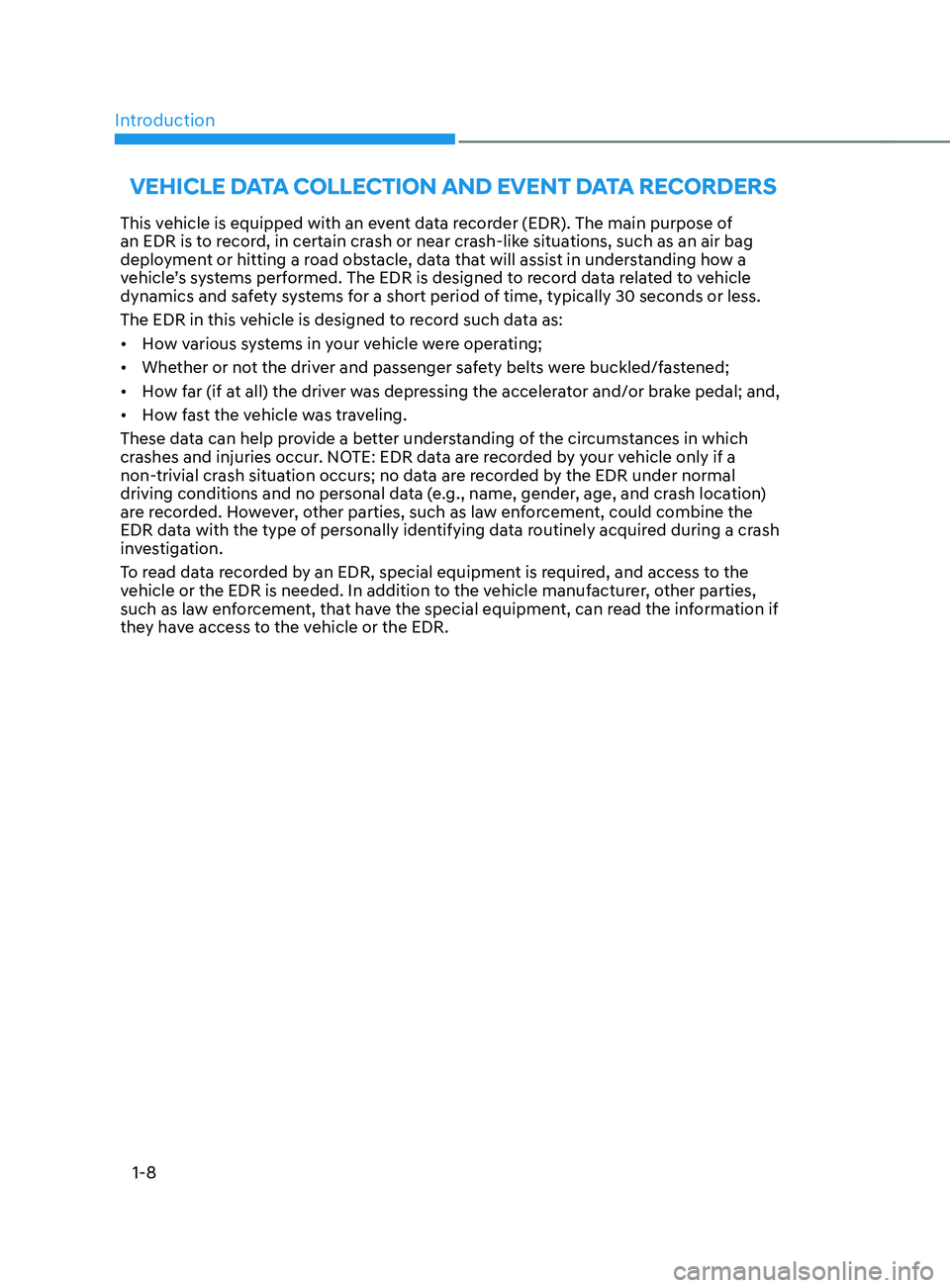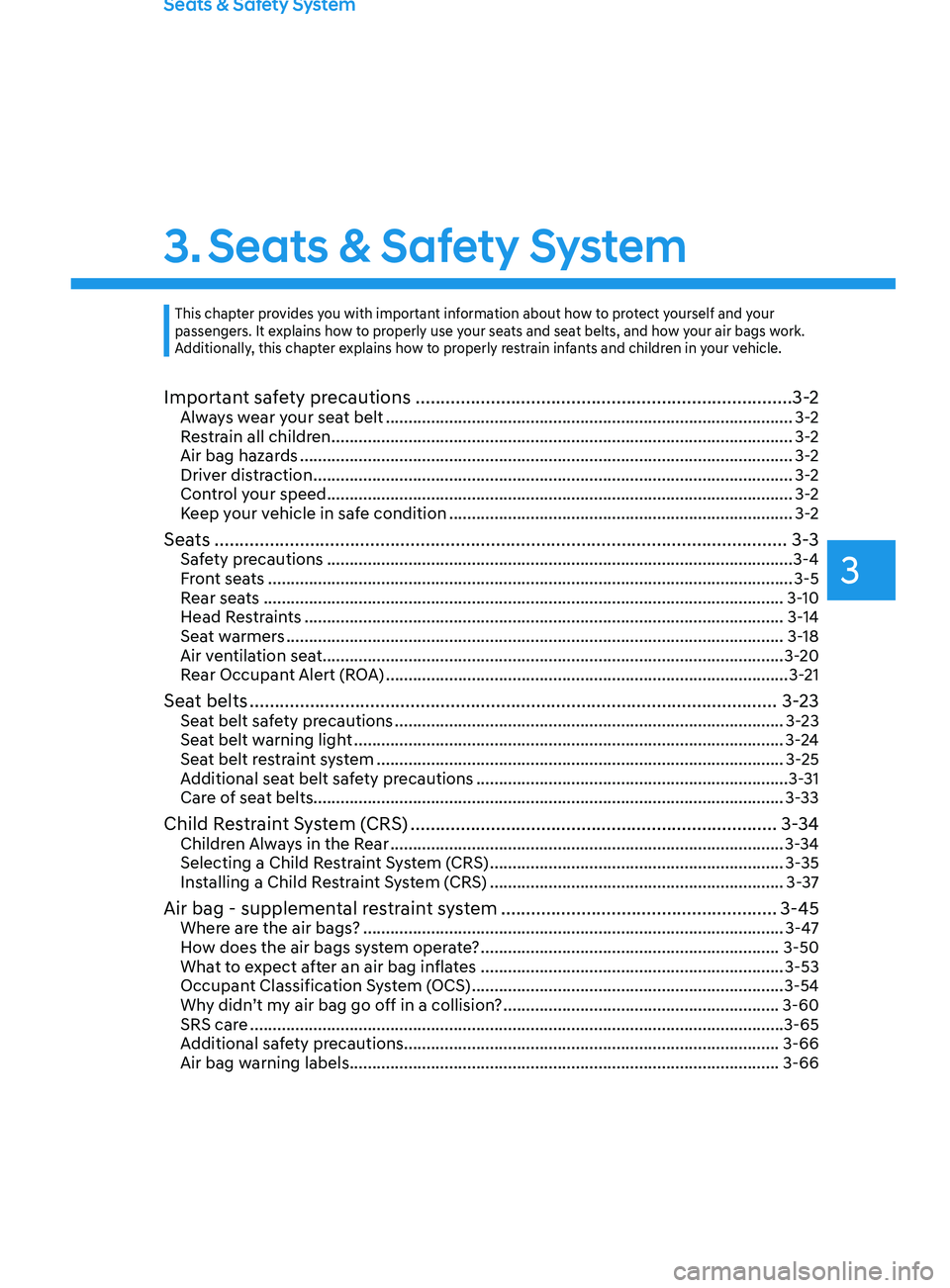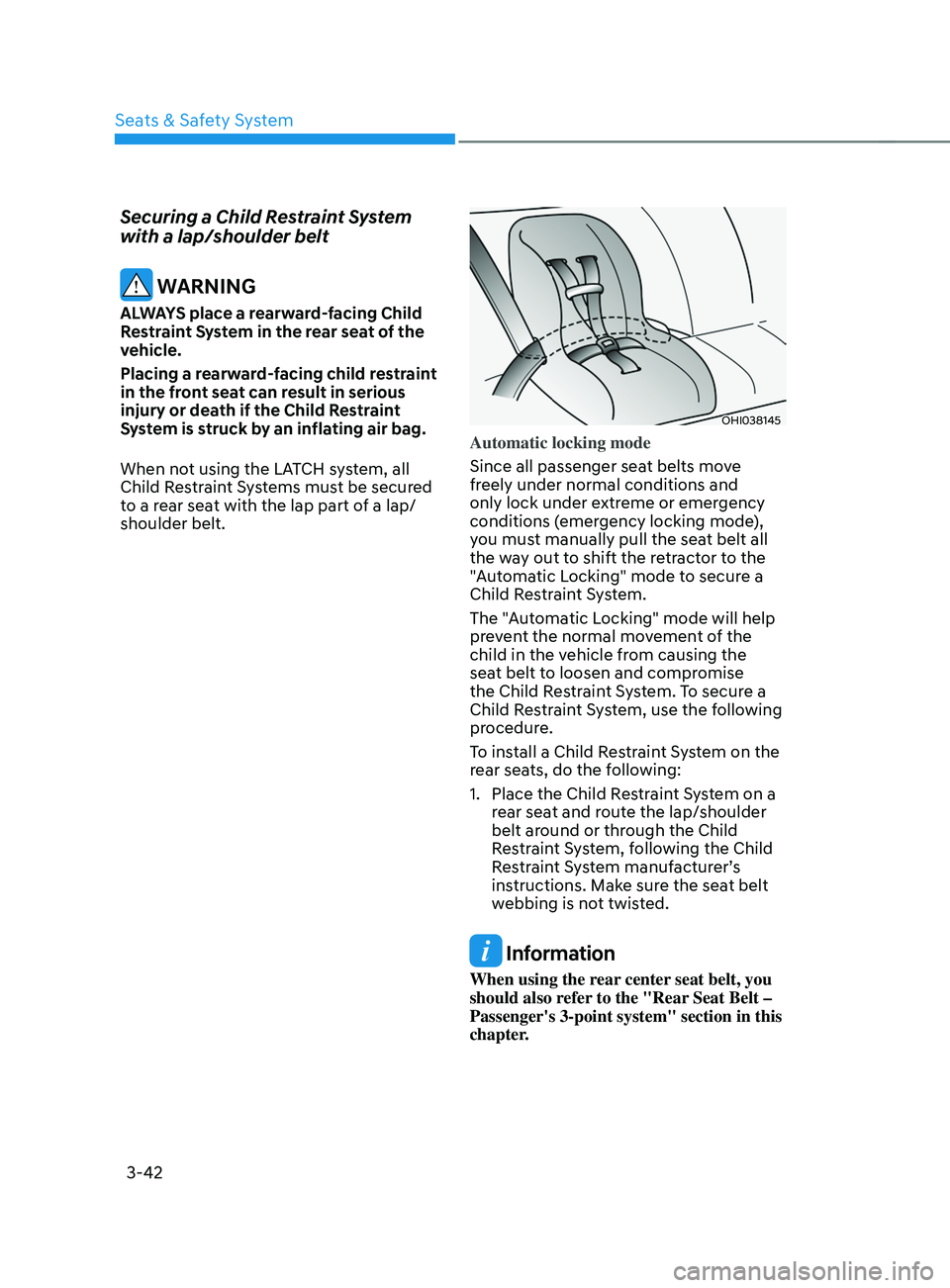2021 HYUNDAI SANTA FE LIMITED air condition
[x] Cancel search: air conditionPage 14 of 636

Introduction
1-8
VEHICLE DATA COLLECTION AND EVENT DATA RECORDERS
This vehicle is equipped with an event data recorder (EDR). The main purpose of
an EDR is to record, in certain crash or near crash-like situations, such as an air bag
deployment or hitting a road obstacle, data that will assist in understanding how a
vehicle’s systems performed. The EDR is designed to record data related to vehicle
dynamics and safety systems for a short period of time, typically 30 seconds or less.
The EDR in this vehicle is designed to record such data as:
• How various systems in your vehicle were operating;
• Whether or not the driver and passenger safety belts were buckled/fastened;
• How far (if at all) the driver was depressing the accelerator and/or brake pedal; and,
• How fast the vehicle was traveling.
These data can help provide a better understanding of the circumstances in which
crashes and injuries occur. NOTE: EDR data are recorded by your vehicle only if a
non-trivial crash situation occurs; no data are recorded by the EDR under normal
driving conditions and no personal data (e.g., name, gender, age, and crash location)
are recorded. However, other parties, such as law enforcement, could combine the
EDR data with the type of personally identifying data routinely acquired during a crash
investigation.
To read data recorded by an EDR, special equipment is required, and access to the
vehicle or the EDR is needed. In addition to the vehicle manufacturer, other parties,
such as law enforcement, that have the special equipment, can read the information if
they have access to the vehicle or the EDR.
Page 15 of 636

2. Vehicle Information, Consumer In formation and
Reporting Safety Defects
Exterior overview (I) ........................................................................\
................... 2-2
Ext erior overview (II)
........................................................................\
.................. 2
-3
Interior overview
........................................................................\
...................... 2-
4
Instrument panel overview (I)
........................................................................\
.. 2-5
Ins
trument panel overview (II)
........................................................................\
. 2-6
E
ngine compartment
........................................................................\
................. 2
-7
Dimensions
........................................................................\
................................ 2-
8
Engine
........................................................................\
........................................ 2-
8
Bulb wattage
........................................................................\
............................. 2-
9
Tires and wheels
........................................................................\
...................... 2
-10
Air conditioning system
........................................................................\
............ 2
-11
Volume and weight
........................................................................\
................... 2
-11
Recommended lubricants and capacities
..................................................... 2
-12
Recommended SAE viscosity number ......................................................................2-1 4
Vehicle Identification Number (VIN) ..............................................................2-1 5
Vehicle certification label
........................................................................\
........ 2
-15
Tire specification and pressure label
.............................................................. 2
-15
Engine number
........................................................................\
......................... 2
-16
Refrigerant label
........................................................................\
...................... 2
-16
Consumer Information
........................................................................\
............ 2
-17
Reporting Safety Defects
........................................................................\
........ 2-1
8
Vehicle Information, Consumer Information and Reporting Safety Defects
2
Page 25 of 636

02
2-11
ItemsWeight of volume Classification
Refrigerant oz. (g)R1234yf
Front22.05 (625) ± 0.88 (25) R-1234yf
Compressor
lubricant oz. (g) Front
3.5 (100) ± 0.35 (10)
PAG
Front + Rear 7.4 (210) ± 0.35 (10)
We recommend you to contact an authorized HYUNDAI dealer for more details.
VOLUME AND WEIGHT
Items Smartstream G2.5 GDi Smartstream G2.5 T-GDi
2WD 4WD 2WD4WD
Gross vehicle weight lbs. (kg)5,137
(2,330) 5,247
(2,380) 5,247
(2,380) 5,357
(2,430)
Luggage volume
Items 5-Seater
SAE
cu.
ft (ℓ)BEHIND 1S
T ROW 72.1 (2,041) ~ *84.6 (2,396)
(*Forward and upright seat position)
BEHIND 2ND ROW 36.4 (1,032) ~ *37.9 (1,075)
(*upright seat position)
AIR CONDITIONING SYSTEM
Page 33 of 636

Seats & Safety System
3. Seats & Safety System
Important safety precautions ........................................................................\
... 3-2Always wear your seat belt ........................................................................\
.................. 3-2
R estrain all children ........................................................................\
.............................. 3
-2
Air bag hazards
........................................................................\
..................................... 3
-2
Driver distraction
........................................................................\
.................................. 3
-2
Control your speed
........................................................................\
............................... 3
-2
Keep your vehicle in safe condition
........................................................................\
.... 3-2
Seats ........................................................................\
.......................................... 3-3Safety precautions ........................................................................\
...............................3-4
Fr ont seats ........................................................................\
..................................... .......3-5
Rear seats
........................................................................\
........................................... 3-
10
Head Restraints
........................................................................\
.................................. 3-
14
Seat warmers
........................................................................\
.....................................
.3-18
Air ventilation seat........................................................................\
..............................3-20 Rear Occupant Alert (ROA)
........................................................................\
................. 3-
21
Seat belts ........................................................................\
.................................3-23Seat belt safety precautions ........................................................................\
..............3-23
Sea t belt warning light ........................................................................\
....................... 3
-24
Seat belt restraint system
........................................................................\
.................. 3-
25
Additional seat belt safety precautions
..................................................................... 3-
31
Care of seat belts........................................................................\
................................ 3-33
Child Restraint System (CRS) ........................................................................\
. 3-34Children Always in the Rear ........................................................................\
............... 3-34
Selecting a Child R estraint System (CRS) ................................................................. 3-
35
Installing a Child Restraint System (CRS)
................................................................. 3-
37
Air bag - supplemental restraint system .......................................................3-45Where are the air bags? ........................................................................\
..................... 3-47
H ow does the air bags system operate? .................................................................. 3-50
Wha
t to expect after an air bag inflates
................................................................... 3-53
Occupan
t Classification System (OCS)
..................................................................... 3-54
Wh
y didn’t my air bag go off in a collision?
............................................................. 3-60
SRS car
e
........................................................................\
.....................................
.........3-65
Additional safety precautions........................................................................\
........... 3-66
Air bag warning labels...........................................................\
.................................... 3-66
This chapter provides you with important information about how to protect yourself and your
passengers. It explains how to properly use your seats and seat belts, and how your air bags work.
Additionally, this chapter explains how to properly restrain infants and children in your vehicle.
3
Page 34 of 636

Seats & Safety System
3-2
You will find many safety precautions
and recommendations throughout this
section, and throughout this manual.
The safety precautions in this section are
among the most important.
Always wear your seat belt
A seat belt is your best protection in all
types of accidents. Air bags are designed
to supplement seat belts, not replace
them. So even though your vehicle is
equipped with air bags, ALWAYS make
sure you and your passengers wear your
seat belts, and wear them properly.
Restrain all children
All children under age 13 should ride
in your vehicle properly restrained in a
rear seat, not the front seat. Infants and
small children should be restrained in
an appropriate Child Restraint System.
Larger children should use a booster
seat with the lap/shoulder belt until they
can use the seat belt properly without a
booster seat.
Air bag hazards
While air bags can save lives, they can
also cause serious or fatal injuries to
occupants who sit too close to them, or
who are not properly restrained. Infants,
young children, and short adults are at
the greatest risk of being injured by an
inflating air bag. Follow all instructions
and warnings in this manual.
Driver distraction
Driver distraction presents a serious and
potentially deadly danger, especially for
inexperienced drivers. Safety should be
the first concern when behind the wheel
and drivers need to be aware of the wide
array of potential distractions, such as
drowsiness, reaching for objects, eating,
personal grooming, other passengers,
and using mobile phones.Drivers can become distracted when
they take their eyes and attention off
the road or their hands off the wheel to
focus on activities other than driving.
To reduce your risk of distraction and an
accident:
•
ALWAYS set up your mobile devices
(i.e., MP3 players, phones, navigation
units, etc.) when your vehicle is
parked or safely stopped.
• ONLY use your mobile device when
allowed by laws and conditions permit
safe use. NEVER text or email while
driving. Most countries have laws
prohibiting drivers from texting. Some
countries and cities also prohibit
drivers from using handheld phones.
• NEVER let the use of a mobile device
distract you from driving. You have a
responsibility to your passengers and
others on the road to always drive
safely, with your hands on the wheel
as well as your eyes and attention on
the road.
Control your speed
Excessive speed is a major factor in crash
injuries and deaths. Generally, the higher
the speed, the greater the risk, but
serious injuries can also occur at lower
speeds. Never drive faster than is safe
for current conditions, regardless of the
maximum speed posted.
Keep your vehicle in safe
condition
Having a tire blowout or a mechanical
failure can be extremely hazardous. To
reduce the possibility of such problems,
check your tire pressures and condition
frequently, and perform all regularly
scheduled maintenance.
IMPORTANT SAFETY PRECAUTIONS
Page 63 of 636

03
3-31
NOTICE
The sensor that activates the SRS
control module is connected with the
pre–tensioner seat belts. The SRS air
bag warning light on the instrument
cluster will illuminate for approximately
3~6 seconds after the Engine Start/Stop
button is in the ON position, and then it
should turn off.
If the pre-tensioner is not working
properly, the warning light will
illuminate even if the SRS air bag is not
malfunctioning. If the warning light
does not illuminate, stays illuminated
or illuminates when the vehicle is
being driven, we recommend the pre-
tensioner seat belts and/or SRS control
module be inspected by an authorized
HYUNDAI dealer as soon as possible.
Information
• Pre-tensioner seat belts may be
activated in certain frontal or side
collisions or rollover situations (if
equipped with rollover sensor).
• When the pre-tensioner seat belts are
activated, a loud noise may be heard
and fine dust, which may appear to be
smoke, may be visible in the passenger
compartment. These are normal
operating conditions and are not
hazardous.
• Although it is non-toxic, the fine dust
may cause skin irritation and should
not be inhaled for prolonged periods.
Wash all exposed skin areas thoroughly
after an accident in which the pre-
tensioner seat belts were activated.
Additional seat belt safety
precautions
Seat belt use during pregnancy
The seat belt should always be used
during pregnancy. The best way to
protect your unborn child is to protect
yourself by always wearing the seat belt.
Pregnant women should always wear
a lap-shoulder seat belt. Place the
shoulder belt across your chest, routed
between your breasts and away from
your neck. Place the lap belt below your
belly so that it fits SNUGLY across your
hips and pelvic bone, under the rounded
part of the belly.
WARNING
To reduce the risk of serious injury or
death to an unborn child during an
accident, pregnant women should
NEVER place the lap portion of the
seat belt above or over the area of the
abdomen where the unborn child is
located.
Seat belt use and children
Infant and small children
Most countries have Child Restraint
System laws which require children to
travel in approved Child Restraint System
devices, including booster seats. The age
at which seat belts can be used instead
of Child Restraint System differs among
countries, so you should be aware of the
specific requirements in your country,
and where you are travelling. Infant and
Child Restraint System must be properly
placed and installed in a rear seat.
For more information refer to the “Child
Restraint Systems” section in this
chapter.
Page 74 of 636

Seats & Safety System
3-42
Securing a Child Restraint System
with a lap/shoulder belt
WARNING
ALWAYS place a rearward-facing Child
Restraint System in the rear seat of the
vehicle.
Placing a rearward-facing child restraint
in the front seat can result in serious
injury or death if the Child Restraint
System is struck by an inflating air bag.
When not using the LATCH system, all
Child Restraint Systems must be secured
to a rear seat with the lap part of a lap/
shoulder belt.
OHI038145
Automatic locking mode
Since all passenger seat belts move
freely under normal conditions and
only lock under extreme or emergency
conditions (emergency locking mode),
you must manually pull the seat belt all
the way out to shift the retractor to the
"Automatic Locking" mode to secure a
Child Restraint System.
The "Automatic Locking" mode will help
prevent the normal movement of the
child in the vehicle from causing the
seat belt to loosen and compromise
the Child Restraint System. To secure a
Child Restraint System, use the following
procedure.
To install a Child Restraint System on the
rear seats, do the following:
1.
Place the Child Res
traint System on a
rear seat and route the lap/shoulder
belt around or through the Child
Restraint System, following the Child
Restraint System manufacturer’s
instructions. Make sure the seat belt
webbing is not twisted.
Information
When using the rear center seat belt, you
should also refer to the "Rear Seat Belt –
Passenger's 3-point system" section in this
chapter.
Page 82 of 636

Seats & Safety System
3-50
How does the air bags system
operate?
OTMH030008N
The SRS consists of the following
components:
(1)
Driver's fr
ont air bag module
(2)
Passenger's fr
ont air bag module
(3)
Side air bag modules
(4)
Curtain air bag modules
(5)
Re
tractor pre-tensioner
(6)
Air bag warning ligh
t
(7)
SRS contr
ol module (SRSCM)/
Rollover sensor
(8)
Fr
ont impact sensors
(9)
Side impact sensors
(10) Side pressure sensors
(11) Seat belt buckle sensor
(12) Emergency fastening device system
(13) Occupant classification system
The SRSCM continually monitors all SRS
components while the ignition switch
is ON to determine if a crash impact
is severe enough to require air bag
deployment or pre-tensioner seat belt
deployment.
SRS warning light
The SRS (Supplemental Restraint System)
air bag warning light on the instrument
panel displays the air bag symbol
depicted in the illustration. The system
checks the air bag electrical system for
malfunctions. The light indicates that
there is a potential problem with your
air bag system, which could include
your side and/or curtain air bags used
for rollover protection (if equipped with
rollover sensor).
WARNING
If your SRS malfunctions, the air bag
may not inflate properly during an
accident increasing the risk of serious
injury or death.
If any of the following conditions occur,
your SRS is malfunctioning:
• The light does not turn on for
approximately three to six seconds
when the Engine Start/Stop button is
in the ON position.
• The light stays on after illuminating
for approximately three to six
seconds.
• The light comes on while the vehicle
is in motion.
• The light blinks when the engine is
running.
We recommend that an authorized
HYUNDAI dealer inspect the SRS
as soon as possible if any of these
conditions occur.